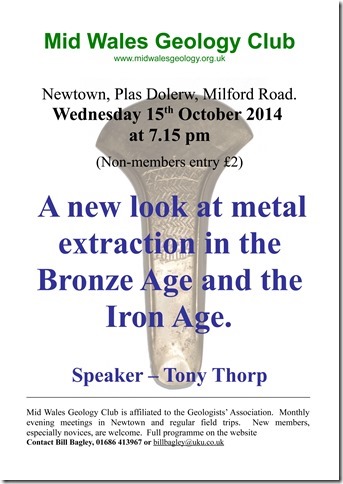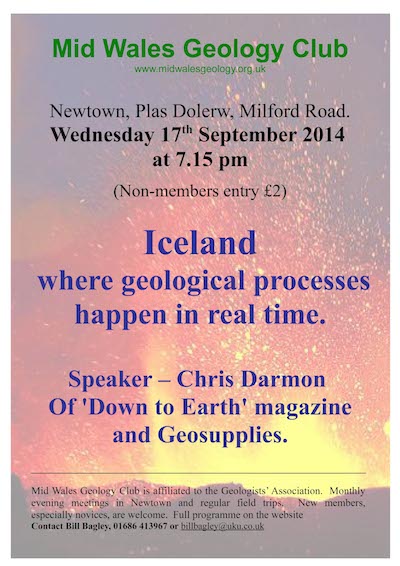Sunday 19th October 2014
Mid Wales Geology Club’s evening meeting on 19 November will be more of a social event than usual. Billed as Mulled Wine, Mince Pies & Murchison, we will show the DVD produced several years ago by the Geology Section of the Woolhope Naturalists Field Club. The Woolhope arranged a re-enactment of the 1850s field visit by the eminent geologist Sir Roderick Murchison, to a site near Aymestrey in Herefordshire. Picnic in Siluria was complete with steam train and a large cast in Victorian costume. It concludes with a short modern footage of a geological visit to a nearby working quarry. Mid Wales Geology Club member Dr Geoff Steel is the current chairman of the Woolhope Geology Section. He says he played the part of a servant, and was not permitted to eat with the gentleman geologists!
Robert Williams, who attended the re-enactment in the guise of Sir Charles Lyell, will set the scene for us, and introduce the characters. Then we will enjoy mulled wine and mince pies (non-alcoholic for those who wish); and afterwards we will watch the DVD. Coffee and tea will be available before we close. We will be at the usual venue, Plas Dolerw, Milford Road, Newtown, commencing at 7.15 pm.
Wednesday 8th October 2014
At the last meeting we were treated to a super talk given by Chris Darmon. He commenced the talk by suggesting that the traditional view of how Iceland came to be where it is is now hotly debated. He would reveal more at the end of the talk!
Iceland is an island that spans the mid-ocean ridge along which the Eurasian and North American plates are moving apart. It also sits atop a mantle plume where magma upwells from from the earth's mantle ( it is this that is now in dispute). And the combination of the two are responsible for Iceland. Geologically Iceland is very young with the oldest rocks exposed at the surface between 14 and 16 million years old. It's surface is constantly changing due to rapid erosion and replenishment from volcanic action.
It is one of the most volcanic places on earth with hundreds of volcanoes many of which commence as fissure eruptions. One of the most deadly volcanoes was the eruption of Laki in 1783/4 which led to huge volumes of Sulphur dioxide being emitted into the upper atmosphere which in turn caused thousands of deaths both in Iceland an other areas of Northern Europe due to starvation and respiratory illness.
The main rock type on Iceland is volcanic and you will find pillow lavas and basalt columns. 90% of the igneous rock is basalt but there is also rhyolite, dacite and andesite present. One anomaly here is the presence of larger amounts of rhyolite compared to similar areas eg. Hawaii. Sedimentary rocks are also present and vary in type from volcanic in origin to lake, river and lagoonal. Thus there are tuffs, shales, mudstones, sandstones and conglomerates. There are even layers containing lignite and coal beds. This suggests that the environment on Iceland has been changing over time. Fossil plants are frequent and contain Angiosperms, Gymnosperms, Horsetails and many others. This suggests that the Miocene Period on Iceland was one of a humid, warm temperate climate. The decline of these species at the end of the Miocene suggests a cooling of the environment.
Most of the population of Iceland live around the coast and inland is deserted. They also make use of all the geothermal energy present for example to heat their homes. Iceland is now a very desirable destination for tourists and Chris has led tours there for the past twenty years.
At the end of the talk Chris presented some evidence to suggest that a mantle plume may not exist under Iceland.
- The spreading rate at the ridges is to fast. This suggests that an expanse of older crust underlies Iceland submerged beneath younger lavas.
- The dating of zircon from the Hvitserker ignimbrite dated to 126-242MYA. That is the Mesozoic. Therefore it was suggested that a continental crust must exist beneath at least part of Iceland.
- The crust is too thick.
- The crust above the mantle plume is not hot.
He went on to say that Gillian Foulger found that her seismic data showed that instead of a long narrow plume of magma coming from deep below Iceland there is actually a broad reservoir of molten rock less than 400km down. This suggests that remnants of crust left behind in the mantle at the fault line have a lower melting point than the surrounding mantle. Where this ancient crustal rock crosses the ridge it should melt more than the rock around it creating a shallow reservoir of magma that feeds Iceland's volcanoes. Thus there is no need for a mantle plume.
This idea of no plume links in with much other research suggesting that mantle plumes have no need to exist to explain other areas like Hawaii. A very controversial area of geology!
The next talk will be on Wednesday 15th October to be given by Tony Thorpe and entitled
“ A new look at metal extraction in the Bronze Age and the iron Age”
Also the members evening will be on Wednesday November 19th and will be a
“Mulled wine, Mince pies and Murchison” evening.

Sunday 7th September 2014
The next event will be on the 17th of September with Chris Darmon's talk “Iceland: Where geological processes happen in real time”

Tuesday 22nd July 2014
The next event will be on August 23rd

Thursday 10th July 2014
The last indoor meeting was a mineral evening led by Bill Bagley. The evening commenced with a talk by Bill about minerals and how to identify them. The talk was accompanied with some super photos of minerals. Bill had also brought in some lovely specimens from his collection. In the second half of the meeting members took part in a quiz in which they had to identify unknown minerals based on information provided. A most enjoyable evening was had by all.
The next meeting is the evening field trip which will be held at Gilfach nature reserve near Rhayader where we shall look at the geology. Meet in the car park at Gilfach at 6.30pm.


